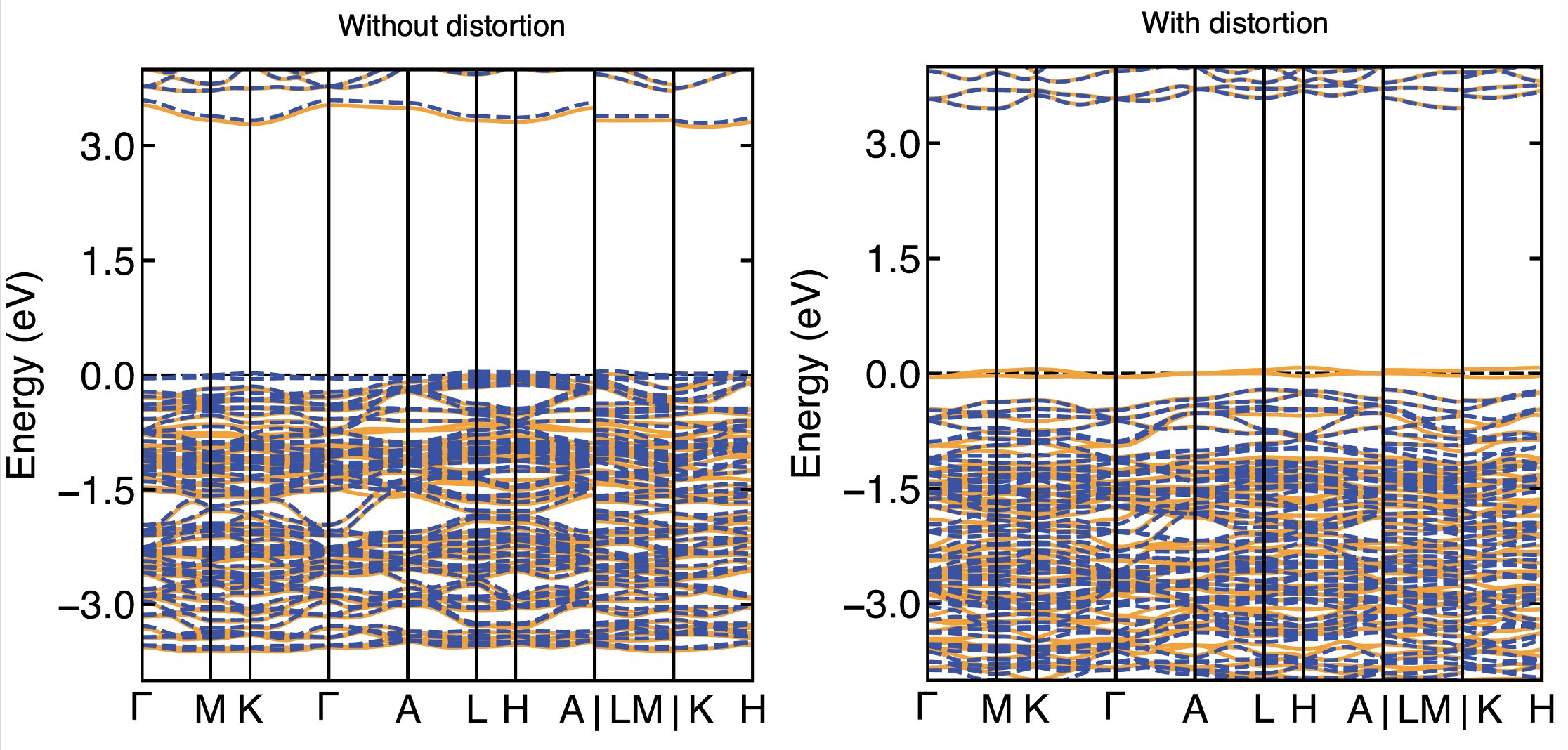Sinéad Griffin, Berkeley Lab researcher, published the simulation of LK99 paper. The paper did *not* prove nor give evidence of superconductivity in Cu-apatite. It showed interesting structural and electronic properties that have features common with high-Tc superconductors provided Cu is in the right place.
Result 3: The electronic structure of Cu on the Pb(2) does not have evidence of these flat bands and instead looks like a regular semiconductor. Moreover Cu is more stable on this Pb(2) site than on the Pb(1) site in the DFT.
What does this mean for the experiments?
If Cu is indeed sitting in the Pb(1) site in the apatite structure as they report, then the DFT calculations suggest that there are interesting flat bands that are a result of the structural distortion.
Flat bands can mean superconductivity, but can also mean a wealth of other phenomena like metal-insulator transitions, charge density waves, magnetism (all interesting!)
The structural distortion and my magnetic calculations of Cu on the Pb(1) also suggest that there might be strong electron-phonon coupling or spin fluctuations in this system (important for the superconducting mechanism)
TLDR: My paper did *not* prove nor give evidence of superconductivity in Cu-apatite. It showed interesting structural and electronic properties that have features common with high-Tc superconductors provided Cu is in the right place. Otherwise we get a ‘boring’ semiconductor.
— Sinéad Griffin (@sineatrix) August 2, 2023
— Sinéad Griffin (@sineatrix) August 2, 2023
There are two inequivalent Pb atoms in the structure – I considered both (called Pb(1) and Pb(2)). They report to have Cu on Pb(1) in the exp (pink). Note: this is the opposite to the labeling in the exp paper however I adopted the conventional labeling used in other literature.
— Sinéad Griffin (@sineatrix) August 2, 2023
It is extremely effective for a wide range of properties, but has its limitations. For one, the approximations made in the implementation of DFT do not deal with strong ‘electron-electron’ interactions well.
— Sinéad Griffin (@sineatrix) August 2, 2023
One of these is called DFT+U where the U is added to the orbitals that we expect to be treated inadequately. In my case, we expect the d-orbitals in Cu need such a treatment. There are several ways of deciding what value of U should be added (e.g. comparing with experiment).
— Sinéad Griffin (@sineatrix) August 2, 2023
(this is a bit weird for this small amount of substitution). I pulled a chemist colleague into my office to ask him if he also thought it was weird. He agreed.
— Sinéad Griffin (@sineatrix) August 2, 2023
Flat bands can mean superconductivity, but can also mean a wealth of other phenomena like metal-insulator transitions, charge density waves, magnetism (all interesting!)
— Sinéad Griffin (@sineatrix) August 2, 2023
The structural distortion and my magnetic calculations of Cu on the Pb(1) also suggest that there might be strong electron-phonon coupling or spin fluctuations in this system (important for the superconducting mechanism)
END OF MEGATHREAD 1
— Sinéad Griffin (@sineatrix) August 2, 2023

Brian Wang is a Futurist Thought Leader and a popular Science blogger with 1 million readers per month. His blog Nextbigfuture.com is ranked #1 Science News Blog. It covers many disruptive technology and trends including Space, Robotics, Artificial Intelligence, Medicine, Anti-aging Biotechnology, and Nanotechnology.
Known for identifying cutting edge technologies, he is currently a Co-Founder of a startup and fundraiser for high potential early-stage companies. He is the Head of Research for Allocations for deep technology investments and an Angel Investor at Space Angels.
A frequent speaker at corporations, he has been a TEDx speaker, a Singularity University speaker and guest at numerous interviews for radio and podcasts. He is open to public speaking and advising engagements.


IIRC, one of the groups reported semiconductor-like properties. That seems consistent with the theoretical prediction for when the Cu ends up in the wrong (but more likely) place.
Is there something else that could dope it with that would preferentially bind to pb(2)? Then follow that with doping of Cu where the only slot left is pb(1)? Is that even possible? Could it improve yield?
I think Chinese proposed that using gold instead cupper should give better results. Don’t know about your combo.
Iris suggest uranium amongst other possibilities
I would try aluminum because it’s lighter then Cu, instead of trying heavier elements like gold. I think may be when less dense copper atoms inserted into heavier pb ones and electricity passes within, copper atoms aren’t able to vibrate individually which prevents energy or power loss. The entire sequence of atoms oscillates together instead, making it superconducting. Aluminum would vibrate even less than copper.
So unexpected distortion caused flat bands, what could be signs of superconductivity.
Now they need to understand if flat bands here are really signs of superconductivity or not something else. It is not clear yet. We will have to wait.
The process (Cu substitution) to cause such distortion and flat bands could be important for creation of room temp, normal pressure superconductors. They can do a lot with simulations of other materials and combinations to determine if “distortions” and flat bands are possible.
If these computer simulations have reached the point of being as good as actual physical proof, what’s to stop entering the desired outcome into the simulation, and letting it run backwards?
I doubt they are that good… yet.
We will have to wait for more serious labs to finish their work. It is not some miracle material, otherwise we would have more positive results. It is not noting, there are some interesting developments and attributes. Most American labs(practical approach) are quiet for now. Drama continues.